Guard stand and die
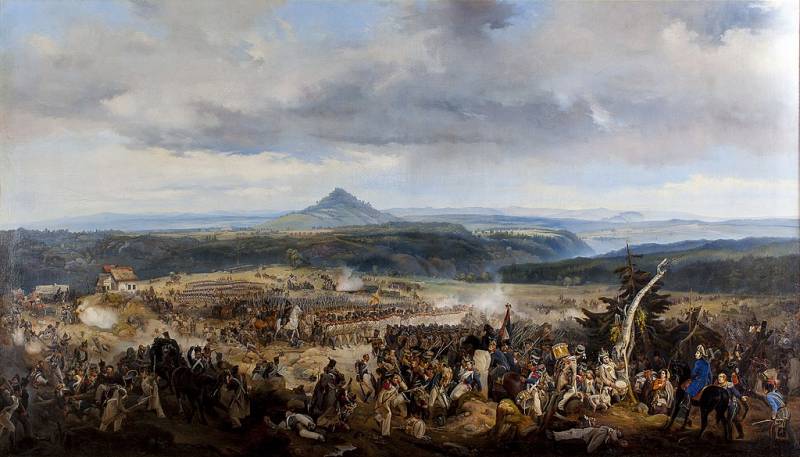
Battle of Gisgubel. Osterman's detachment makes its way to Teplitz. Fragment of a painting by B. Villevalde
General situation
After the defeat at Dresden (Napoleon's victory in the battle of Dresden) The southern army retreated in three columns through the Ore Mountains to Bohemia (as the Czech Republic was then called). The Austrian columns went through Tarant to Freiberg and through Dippoldiswalde and Eichwald to Teplitz. Russian-Prussian troops under the overall command of Barclay de Tolly marched through the Don and Zegist, then along the highway through Peterswalde to Teplitz. The enemy's occupation of both main routes from Dresden, to Pirna and Freiberg, forced the first Austrian column and the Russian-Prussian column to deviate from the directions they had indicated.
On August 15 (27), 1813, Napoleon, trying to cut off the enemy’s escape route, sent the 1st Army Corps (32–35 thousand soldiers, 84 guns) in a roundabout maneuver through Peterswalde to Teplitz. Bonaparte promised Vandamme to send him the corps of Saint-Cyr and Marmont to help him. When the French successfully completed the task set by Napoleon, the Allied forces found themselves in a critical situation. Vandam's capture of Teplitz blocked the narrow route through the Ore Mountains to the Allied forces. When the main forces of the French approached, the allied troops, with the Russian sovereign and the Prussian king, were in danger of encirclement and defeat.
In Dippoldiswalde there was a great crowd of allied troops, artillery, convoys, and mobile stores. Rain and bad roads slowed down the movement of troops. If the French had quickly pursued the Allies, the Allies would have been in deep trouble. However, the French army did not pursue the opponents.
At first, Napoleon wanted to catch up with the enemy. On August 28, the troops of Murat, Lautour-Maubourg and Victor moved to Freiberg, Marmont - in Dippoldiswalde, Saint-Cyr - to the Don, and then Maxen, the guard arrived in Pirna. On the evening of August 28, the emperor with the guards was in Pirma, 30 versts from Kulm. The next day, he could come to the aid of Vandam's corps and close the road to the allies, who were stretched along the narrow mountain roads. From the rear, the allied troops blocked the troops of Murat, Marmont and Saint-Cyr. But the next day the Old Guard was ordered to return to Dresden. The allied army avoided a possible catastrophe.
Some researchers attribute this decision to the illness of the French emperor. Others talk about the impact of news of Oudinot's defeat near Berlin (How Bülow's Prussians defeated Rainier's Saxons and saved Berlin) and the defeat of MacDonald's troops at Katzbach (Battle of Katzbach).
These news of the failures of the French troops attracted all Napoleon's attention to the Berlin direction and Silesia, from where enemy armies could emerge. Therefore, the Old Guard with Napoleon returned to Dresden, the Young Guard received orders to remain in Pirna.
Other corps, although they continued the pursuit, did so slowly, carefully, limiting themselves to capturing stragglers (mostly Austrians) and abandoned convoys. But Vandam’s corps, which was located in the most important and dangerous direction, did not receive any specific instructions. The 1st French Corps was left alone.
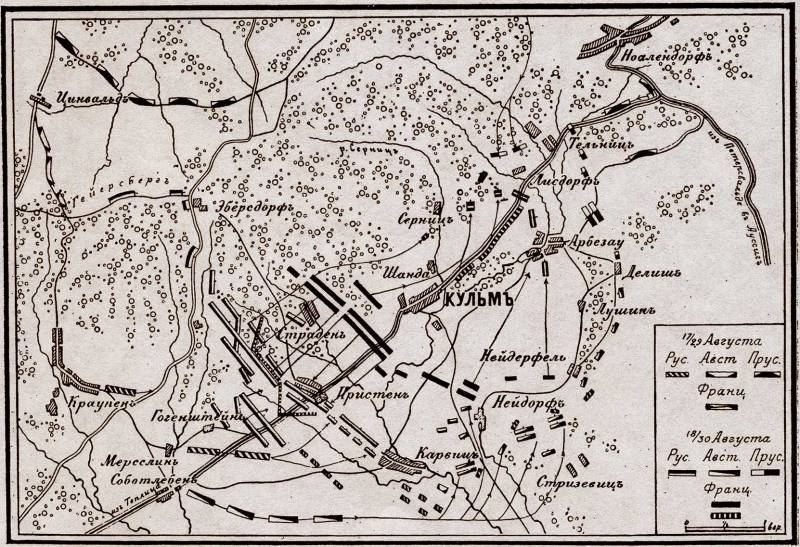
First fights
On the way of the French corps there were 10 thousand. a Russian detachment under the command of Count Osterman-Tolstoy (already during the battle reinforcements approached him). The Osterman-Tolstoy Combined Detachment included: the 1st Guards Division under the command of Major General Rosen (Preobrazhensky, Semyonovsky, Izmailovsky, Life Guards Jaeger regiments), several regiments of the 2nd Army Corps of Eugene of Württemberg, and Gelfreich’s detachment. Osterman received orders not to allow French troops to exit the mountain gorges.
The first skirmishes began on August 28. The fighting took place near the villages of Gross-Kotty, Krichwitz, and Kolberg. While the guard was marching towards Gisgübel (Gissgübel), under the nose of the French corps, part of the detachment’s forces attacked the enemy. Wolf's brigade (Murom and Chernigov regiments) overthrew the enemy beyond Krichwitz, where the Russian riflemen held out for up to 16 hours. Knorring's detachment, with the support of a battalion of life rangers and a battalion of Semyonovites under the personal command of Ermolov, attacked Kolberg.
The French had no information about the size of the enemy forces opposing them, exaggerating their numbers. Vandam was misled by the decisiveness of the actions of the Russian detachment. The further advance of the detachment was accompanied by constant battles with French troops.
So, at Gisgubel the guards had to clear the road from French riflemen. This fight was included in history Russian guard and army.
The vanguard of the column, headed by the Preobrazhensky Life Guards Regiment, was met by dense enemy artillery and rifle fire. The Guards battery silenced the French artillery. The commander of the 1st Guards Division, Rosen, turned the regiment around and personally ordered the 2nd Battalion to pave the way with bayonets.
The Preobrazhensky soldiers in dark green uniforms with red trim, led by their commander Colonel Nikanor Svechin, crushed the French with a swift bayonet attack. Russian soldiers used bayonets to pave the way for the entire detachment. The attack of the Svechin guards was truly lightning fast. Those who followed in the column did not even notice that the leading battalions of the Preobrazhensky soldiers were fighting a fierce battle. The usually reserved Count Osterman-Tolstoy, observing what was happening, could not and did not want to hide his delight and admiration for the courage and bravery of the guard brothers.
For the dashing attack near Gisgyubeluy, Colonel Nikanor Svechin was awarded the Order of St. George, 4th degree, and for Kulm he was promoted to major general. He was honored to receive gratitude from three European monarchs at once - the Russian emperor, the Prussian king and the Austrian emperor. His name became famous among the entire guard.
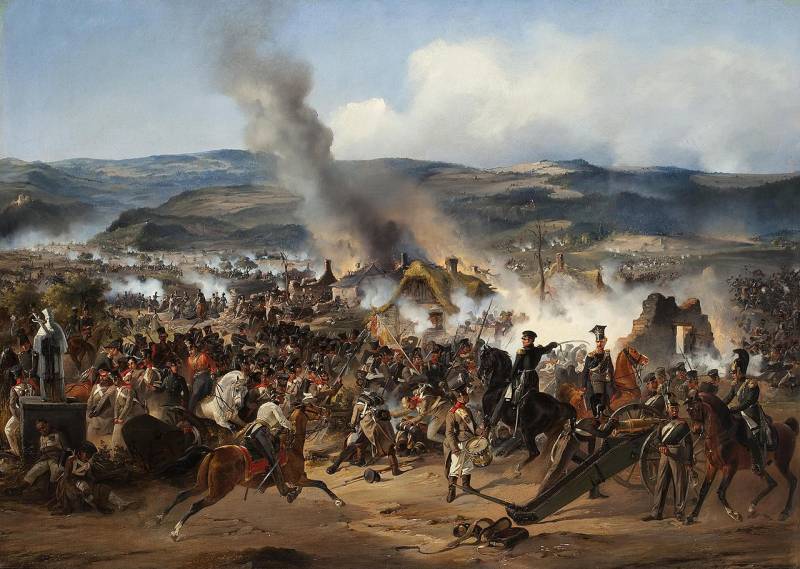
Battle of Kulm. A. E. Kotzebue
French offensive
On August 29, at dawn, French troops pushed Osterman-Tolstoy’s detachment away from Kulm towards Teplitz. Russian troops took up defense southwest of Kulm near the village of Pristen, forming in two lines. Osterman concentrated his main efforts on his left flank, along the Kulm-Teplice road. On the right flank, Russian forces were positioned on hilly terrain.
Osterman-Tolstoy called on the troops to hold on to their position “to the last extremity” and “or die a glorious death on the battlefield,” but to give time to the main forces of our army and the Russian sovereign to get out of the mountain gorges. He was supported by Tsarevich Konstantin Pavlovich, who, during a tour of the troops, addressed the guards with the words: “Guys, friends! Emperor in the mountains. Save the king!
Vandam, hoping that only the appearance of the forces of his corps would force the Russians to retreat and, in a hurry to occupy Teplitz, did not wait for the concentration of all forces and introduced units into battle as they remained. The Reiss brigade (6 battalions) was the first to attack. Around noon, she attacked Russian positions near the village of Straden. The enemy attack was repulsed, and the commander of the French brigade, Prince of Reis, was killed. Ermolov supported the life rangers with the Semenovsky regiment, and the French retreated.
At this time, the 42nd Mouton-Duvernay Division (9 battalions) entered against the Russian left wing. The Russian riflemen were driven out of the forest near Straden. Vandam deployed Corbino's cavalry (20 squadrons) and sent Gobrecht's brigade (8 squadrons) from Kulm on both sides of the highway. At about 14 p.m., Philipon's division (14 battalions) arrived. Vandam, hoping to solve the matter with one decisive blow, sent one regiment to Straden and three to Pristen. The Russian riflemen left Straden, but when two French battalions carelessly rushed to pursue them, they surrounded them in the forest and, for the most part, killed or captured them.
There was a bloody hand-to-hand battle. The Semenovsky regiment lost up to half of its strength. Ermolov, who reported to Osterman about the huge losses, heard in response: “Stand still and die!”
Pristen changed hands several times. The French ousted the fighters of the 2nd Corps from it. Then Prince Shakhovsky with the 4th Jaeger, Revel and Minsk regiments recaptured the village. The French, suffering heavy losses from Russian artillery fire, again moved to attack. Württemberg asked for reinforcements. Tolstoy had only three battalions left in reserve (two from the Izmailovsky regiment and one from the Preobrazhensky regiment). The reserve hit the enemy. The French were driven back. But the Russian troops also suffered heavy losses. The commander of the Izmailovsky Life Guards Regiment, Matvey Khrapovitsky, was seriously wounded.
At this time, Tolstoy’s detachment received reinforcements - the 1st Cuirassier Division arrived under the command of Major General Depreradovich. Two cuirassier regiments - the Cavalry Guard and the Cavalry - took up defense on the right flank, where the sides were separated by a ravine, and the Life Guards Uhlan and Dragoon regiments deployed on the left flank.
At about 17 p.m., French troops attacked the left flank of the Russian troops in two columns. The French broke through the Russian defenses, captured Pristen, but were stopped by a bayonet attack by a battalion of the Semenovsky regiment. The Semyonovites recaptured the guns of a battery captured by the French. At this moment, the Life Guards Uhlan and Dragoon regiments under the command of Ivan Dibich struck the French. One French column was able to hide in the forest, the other entered the battle and was defeated. Only up to 500 people were taken prisoners.
This was the end of active hostilities that day. The Russian detachment suffered heavy losses - up to 6 thousand people, but withstood the enemy's attack, eliminating the threat of encirclement and defeat of the retreating allied army.
The battle was extremely fierce. Both sides showed bravery and courage. Osterman-Tolstoy was wounded, his left hand, broken by a cannonball, was cut off. He responded to words of sympathy:
Command of the troops was assumed by General Alexei Ermolov, commander of the 5th Guards Corps. Ermolov completed the task perfectly. The Russian guards saved the entire army with their heroic self-sacrifice. According to Denis Davydov, “the famous Battle of Kulm, which on the first day of this battle, great in its consequences, belonged primarily to Ermolov, serves as one of the decorations of this general’s military career.” It was not for nothing that the commander was awarded the Order of St. Alexander Nevsky right on the spot of the battle, and the Prussian king presented him with the Red Eagle Cross of the 1st degree.
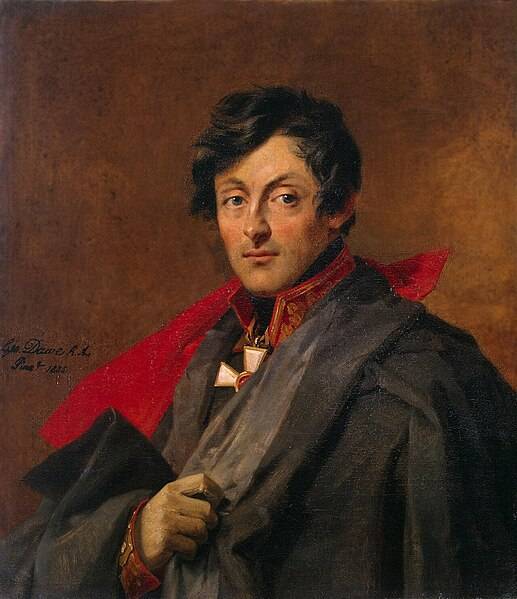
Portrait of Alexander Ivanovich Osterman-Tolstoy. D. Doe
The defeat of the French corps
In the evening, Barclay's main forces began to approach Teplitz. At night, Ermolov's detachment was reinforced by the 2nd Cuirassier Division and part of the 3rd Infantry Corps. They replaced the bloodless and battle-weary units of the 1st Guards Division on the front line. Overall command was assumed by Miloradovich, and then Barclay.
Around the same time, Kleist’s Prussian corps (35 thousand) passed through the same valley in the mountains as the French and went to the rear of the enemy. This came as a surprise to both the Prussians and the French. Vandamme even initially believed that these were reinforcements from Saint-Cyr. The total number of allied troops in the battle area increased to 50–60 thousand people.
Barclay placed the 1st Grenadier Division under the command of Raevsky and the Pyshnitsky brigade on the left flank in the first line; the Austrian brigade of the Prince of Hesse-Homburg was located in the second line. The general leadership of the left flank was carried out by Prince Golitsyn. In the center in the first line was the 2nd Corps of Eugene of Württemberg and Gelfreich’s detachment, in the second line were the 2nd Guards Infantry Division of Major General Udom, the Guards cavalry and the Austrian cuirassiers. The 3rd Cuirassier Division of Duca was also located here. Overall command was exercised by Miloradovich. On the right wing were Knorring's cavalry detachment (he was seriously wounded in this battle), the Austrian divisions of Colloredo and Bianchi. The right flank had to bypass the enemy. The right flank was led by the Austrian commander Colloredo.
French troops that day continued to attack the left flank of the Allied forces. Russian troops attacked on both flanks, and Austrian troops tried to get around the enemy's left flank. By noon, the Prussians came to the rear of the French. Vandam was forced to turn part of his forces against Kleist and counterattacked him. The Prussian troops were thrown back several kilometers to the north, but only the cavalry brigade of General Corbino was able to break through the corridor and escape.
The French, attacked from three directions, were crushed and defeated. By 13:12 the French troops began to surrender. Up to 80 thousand people, along with the commander and all the artillery (XNUMX guns), fell into the hands of the Allies. Others fled into the forests.
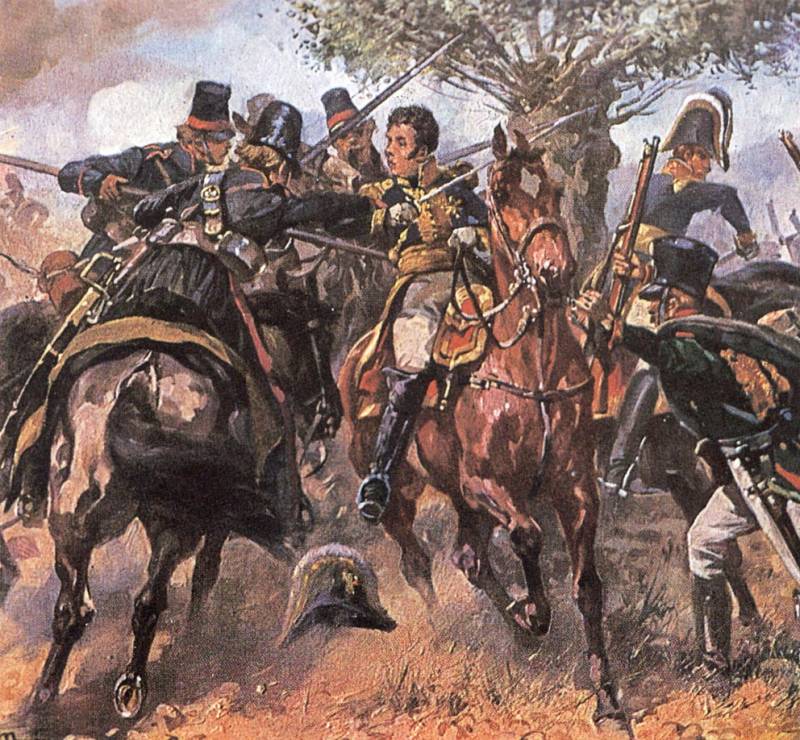
General Dominique Vandamme is captured by the Russians. Hood. Fritz Neumann
Results
The Allied army, thanks to the courage and self-sacrifice of thousands of Russian soldiers, avoided encirclement. The threat of a possible military catastrophe was eliminated. Napoleon did not build on his success at Dresden. The Austrians, who still doubted the future of the anti-French coalition, did not leave it.
The French 1st Corps under the command of Dominique Vandamme was completely defeated. In the battle of Kulm, French troops lost up to 5 thousand killed, all their artillery and convoys. There were about 12 thousand prisoners. The total losses of the French corps are estimated at 17–22 thousand people; some of the soldiers fled into the forests and later joined their army. Napoleon had to form a new corps, but in fact the 1st Corps never regained its combat effectiveness until the end of the campaign.
The Allied forces lost about 10 thousand people, of which 7 thousand were Russians. Most of the losses occurred on the first day of the battle. The guardsmen suffered significant losses: the Semenovsky regiment lost 900 people killed and wounded, that is, half of its payroll, the Izmailovsky regiment - 551 people, etc.
For Tsar Alexander, this was the first victory at which he was present, so it became special for him. According to the adjutant of the Russian sovereign, Mikhailovsky-Danilevsky, who later became a prominent military historian, “The battle of Kulm was always his favorite subject of memory.”
Osterman-Tolstoy was awarded the Order of St. George, 2nd degree and the Prussian Great Iron Cross. Russian guardsmen were awarded the Insignia of the Iron Cross (Kulm Cross).
Many generals who took part in the battle were promoted: Osterman-Tolstoy became adjutant general of Alexander I, Rosen and Depreradovich were promoted to lieutenant general. The Russian Tsar granted 2 rubles to the soldiers. The guards squadrons were allocated three soldiers' St. George's Crosses; they were to be awarded to those "who, by the choice of their brethren, were chosen to be worthy of receiving."
In Austria, in honor of the victory near Kulm, a monument was erected and a medal minted with the inscription: "To the courage of the Russian Guards at Kulm."
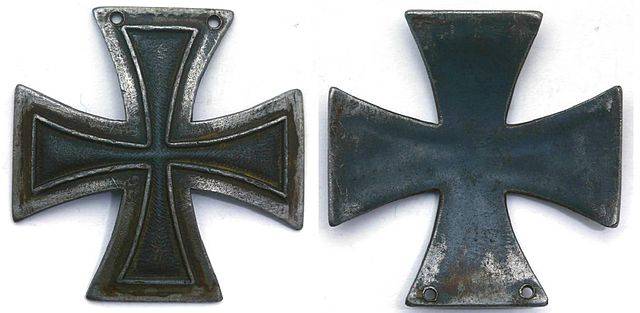
Soldier's Kulm Cross
Information